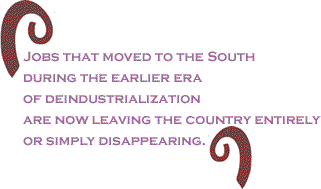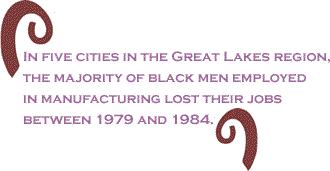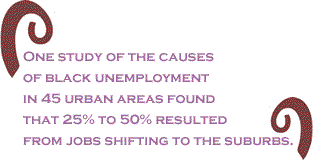
|
|||||||||||||||||||||
|
This article originally appeared in Dollars & Sense: The Magazine of Economic Justice. In July 2003, Mary Clark saw a notice posted by the time clock at the Pillowtex plant where she worked: the plant was closing down at the end of the month. The company would be laying off 4,000 workers. "They acted like we was nobody," she said; Pillowtex even canceled the workers’ accrued vacation days. Clark had worked at the textile plant in Eden, North Carolina, for 11 years, inspecting, tagging, and bagging comforters. By 2003, she was earning more than $10 an hour. Clark’s unemployment benefits don’t cover her bills. Because Pillowtex had sent her and her coworkers home frequently for lack of work in the final year, her unemployment checks are low, based on that last year’s reduced earnings. She lost her health coverage, and now she needs dental work that she cannot afford.
It’s happening again. In the 1970s, a wave of plant closings hit African Americans hard. Two generations after the "Great Migration," when millions of black people had left the South to take factory jobs in Northern and Midwestern cities, the U.S. economy began to deindustrialize and many of those jobs disappeared – in some cases shifted to the low-wage, nonunion South.
Media coverage of today’s unemployment crisis often showcases white men who have lost high-paying industrial or information-technology jobs. But Mary Clark is actually a more typical victim. Recent job losses have hit black workers harder than white workers: black unemployment rose twice as fast as white unemployment in the last recession. Once again, African Americans are getting harder hit, and once again, they face a downturn with fewer of the resources and assets that tide families over during hard times. Last Hired, First Fired
The tight labor market of the late 1990s was very beneficial for African Americans. The black unemployment rate fell from 18% in the 1981-82 recession, to around 13% in the early 1990s, to below 7% in 1999 and 2000, the lowest black unemployment rate on record. But the 2001 recession (and the job-loss recovery since then) has robbed African Americans of much of those gains. "The last recession has had a severe and disproportionate impact on African Americans and minority communities," according to Marc H. Morial, president of the National Urban League. In its January 2004 report on black unemployment, the Urban League found that the double-digit unemployment rates in the 14 months from late 2002 through 2003 were the worst labor market for African Americans in 20 years. The 2001 recession was hard on African American workers both in relation to earlier recessions and in relation to white workers. Unemployment for adult black workers rose by 2.9 percentage points in the recession of the early 1980s, but by 3.5 in the 2001 recession. White unemployment, in contrast, rose by only 1.4 percentage points in the early-1980s recession and by 1.7 in the recent downturn. The median income of black families fell 3% from 2001 to 2003, while white families lost just 1.7%. Today, black unemployment has remained above 10% for over three years. Official unemployment figures, of course, greatly understate the actual number of adults without jobs. The definition doesn’t include discouraged people who have stopped looking for work, underemployed part-timers, students, or those in prison or other institutions. In New York City, scarcely half of African-American men between 16 and 65 had jobs in 2003, according to the Bureau of Labor Statistics’ employment-to-population ratios for the city. The BLS ratios, which include discouraged workers and others the official unemployment statistics leave out, were 51.8% for black men, 57.1% for black women, 75.7% for white men, and 65.7% for Latino men. The figure for black men was the lowest on record (since 1979). Manufacturing job losses in particular have hit black workers harder than white workers. In 2000, there were 2 million African Americans working in factory jobs. Blacks comprised 10.1% of all manufacturing workers, about the same as the black share of the overall workforce. Then 300,000 of those jobs, or 15%, disappeared. White workers lost 1.7 million factory jobs, but that was just 10% of the number they held before the recession. By the end of 2003, the share of all factory jobs held by African Americans had fallen to 9.6%. "Half a percentage point may not sound like much, but to lose that much in such an important sector over a relatively short period, that is going to be hard to recover," said Jared Bernstein of the Economic Policy Institute, a progressive economics think tank. Latino workers increased their share of manufacturing jobs in 2002 and 2003 slightly, though their unemployment rate overall rose.
Some of the largest layoffs have occurred in areas with large African-American populations – just this April, for example, 1,000 jobs were cut at a Ford plant in St. Louis and 300 at a Boeing plant in San Antonio. Textile plants with mostly black employees have closed in Roanoke Rapids, N.C., Columbus, Ga., and Martinsville, Va. The states with the greatest number of layoffs of 50 workers or more are black strongholds New York and Georgia. When Autoliv closed its seat belt plant in Indianapolis in 2003, more than 75% of the laid-off workers were African Americans. Many of these workers are young adults who got their jobs during the labor shortage of the late 1990s even without a high school diploma; now they have few options. "They were taken from the street into decent-paying jobs; they were making $12 to $13 an hour. These young men started families, dug in, took apartments, purchased vehicles. It was an up-from-the-street experience for them, and now they are being returned to their old environment," said Michael Barnes, director of an Indiana AFL-CIO training program for laid-off workers. U.S. Chamber of Commerce executive vice president Bruce Josten isn’t too worried about layoffs: "We’re talking about transformational evolution – successful companies remaking their own operations so they’re able to better focus on what their core mission is. It’s not a deal where everyone gains instantly. At a micro level, there’s always going to be a community that’s hurt." The communities that are hurt come in all colors, but several factors make the micro level pain more severe in communities of color. Hard Times Hit Blacks Harder Prolonged unemployment is scary for most families, but it puts the typical African-American family in deeper peril, and faster. The median white family has more than $120,000 in net worth (assets minus debts). The median black family has less than $20,000, a far smaller cushion in tough times. Laid-off workers often turn to family members for help, but with almost a quarter of black families under the poverty line, and one in nine black workers unemployed, it’s less likely that unemployed African Americans have family members with anything to spare. Black per capita income was only 57 cents for every white dollar in 2001. When homeowners face prolonged unemployment, they can take out a home equity loan or second mortgage to tide them over. But while three-quarters of white families are homeowners, less than half of black families own their own homes. And thanks to continuing segregation and discrimination in housing, it’s more difficult for black families to relocate to find work. New jobs are concentrated in mostly white suburbs with little public transportation. History Repeats Itself
The term "deindustrialization" came into everyday use in the 1970s, when a wave of plant closings changed the employment landscape. From 1966 to 1973, corporations moved over a million American jobs to other countries. Even more jobs moved from the Northeast and Midwest to the South, where unions were scarce and wages lower. New York City alone lost 600,000 manufacturing jobs in the 1960s.
A major reason was seniority: white workers had been in their jobs longer, and so were more likely to keep them during cutbacks. Another reason was geography. The Northern cities that lost the most jobs were some of those with the largest populations of people of color, and those inner-city areas sank deep into poverty and chronically high unemployment as few heavily white areas did. The race and class politics of deindustrialization are also part of the story. The pro-business loyalties of the federal government dictated policies that encouraged plant closings and did very little to mitigate their effects. Tax credits for foreign investment and for foreign tax payments encouraged companies to move plants overseas. While Northern cities were suffering from deindustrialization, the federal government spent more in the Southern states than in the affected areas: Northeast and Midwest states averaged 81 cents in federal spending for each tax dollar they sent to Washington in the 1970s, while Southern states averaged $1.25. Laid-off black factory workers had no clout, so politicians faced little pressure to address their needs.
As dramatic as the movement of jobs from the North to the South and overseas was the shift from city to suburb. The majority of new manufacturing jobs in the 1970s were located in suburban areas, while manufacturing employment fell almost 10% in center cities. In the Los Angeles area, for example, older plants were closing in the city while new ones opened in the San Fernando Valley and Orange County. The new suburban jobs were usually inaccessible for African Americans and other people of color because of housing costs, job and housing discrimination, lack of public transportation, and lack of informal social networks with suburban employers. In a study of Illinois firms that moved to the suburbs from the central cities between 1975 and 1978, black employment in the affected areas fell 24%, while white employment fell less than 10%. In another study, some employers admitted to locating facilities in part so as to avoid black workers. One study of the causes of black unemployment in 45 urban areas found that 25% to 50% resulted from jobs shifting to the suburbs. Even the federal government shifted jobs to the suburbs: although the number of federal civilian jobs grew by 26,558 from 1966 to 1973, federal jobs in central cities fell by 41,419. Over time, suburban white people gained a greater and greater geographic edge in job hunting. Looking Forward Mary Clark has been looking for work for nine months now without success. Stores get applications from hundreds of other laid-off workers; there aren’t enough jobs for even a fraction of the nemployed. "It used to be that if one plant shut down, there’d be another one hiring. Now they’re all laying off or closing," she says.
For years Clark had helped her grown daughter support her two small children. "Now the roles are reversed, and they help me." She has turned to charities to make ends meet, but some give aid only once a year, and others won’t help a single woman without children at home. "It breaks your self-esteem to have to ask for help," Clark says. Some of her former coworkers are in more desperate straits than he is. Some have lost their homes or gone into bankruptcy. Some people have found jobs far from home and commute for hours a day. Clark sees crime, divorce, and family violence all rising in the area. What job growth there’s been has been concentrated in the low-wage service sector, which pays less than the shrinking manufacturing sector. There’s no law of nature that says service jobs are inevitably low paid and without benefits. Or that manufacturing can’t revive in the United States. The recent wave of union organizing victories in heavily black industries such as ealth care represent one source of hope for creating more decent jobs for African Americans. Dr. Martin Luther King Jr. said in 1968, "When there is massive unemployment in the black community, it is called a social problem. But when there is massive unemployment in the white community, it is called a depression." The New Deal response to the Great Depression included public works jobs and a strengthened safety net, most of which excluded people of color. Mary Clark clearly recognizes what happens when there is no New Deal for unemployed African Americans: "North Carolina has people who want to work, but we don’t have anyone pushing work our way. We need the mills back. We’re people used to working, and when you take the work away, what do you have left?" Betsy Leondar-Wright is the Communications Director at United for a Fair Economy and co-author of UFE’s 2004 report, "The State of the Dream: Enduring Disparities in Black and White." |
June
17 2004 |
|||||||||
|
|||||||||
|
|
|||||||||
| Printer Friendly Version | |||||||||
 |
|||||||||
| |
|||||||||
| |
|||||||||

































